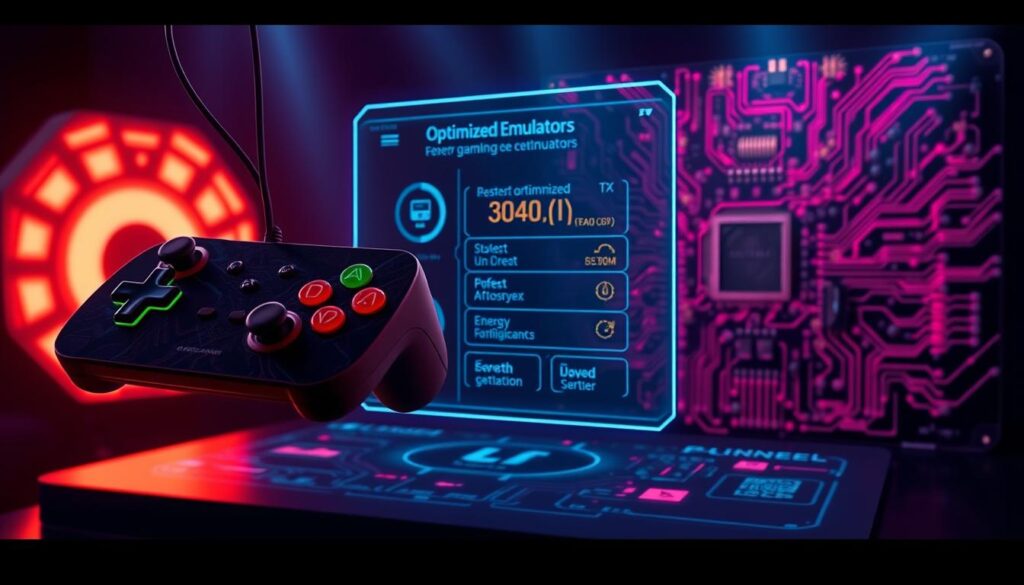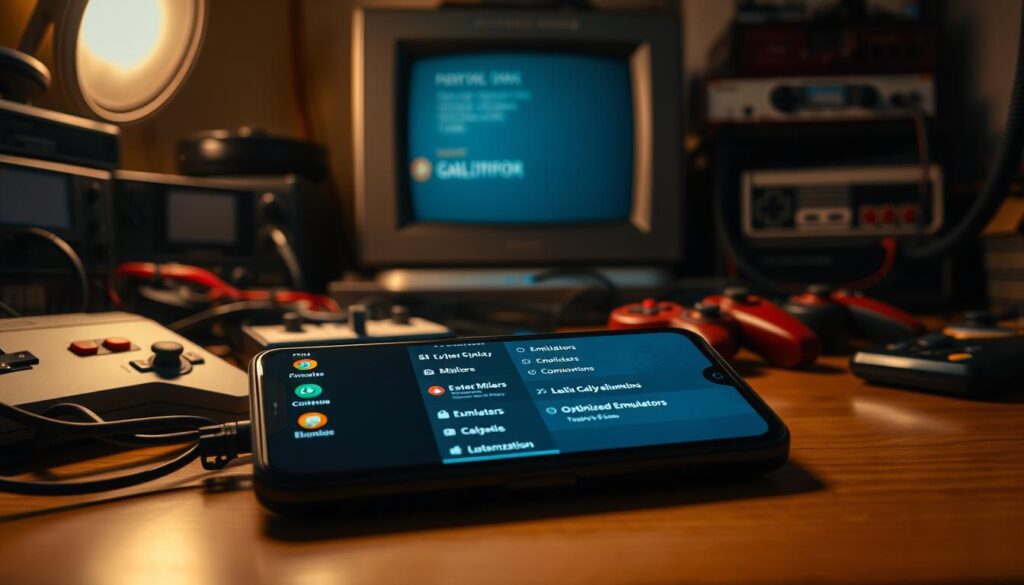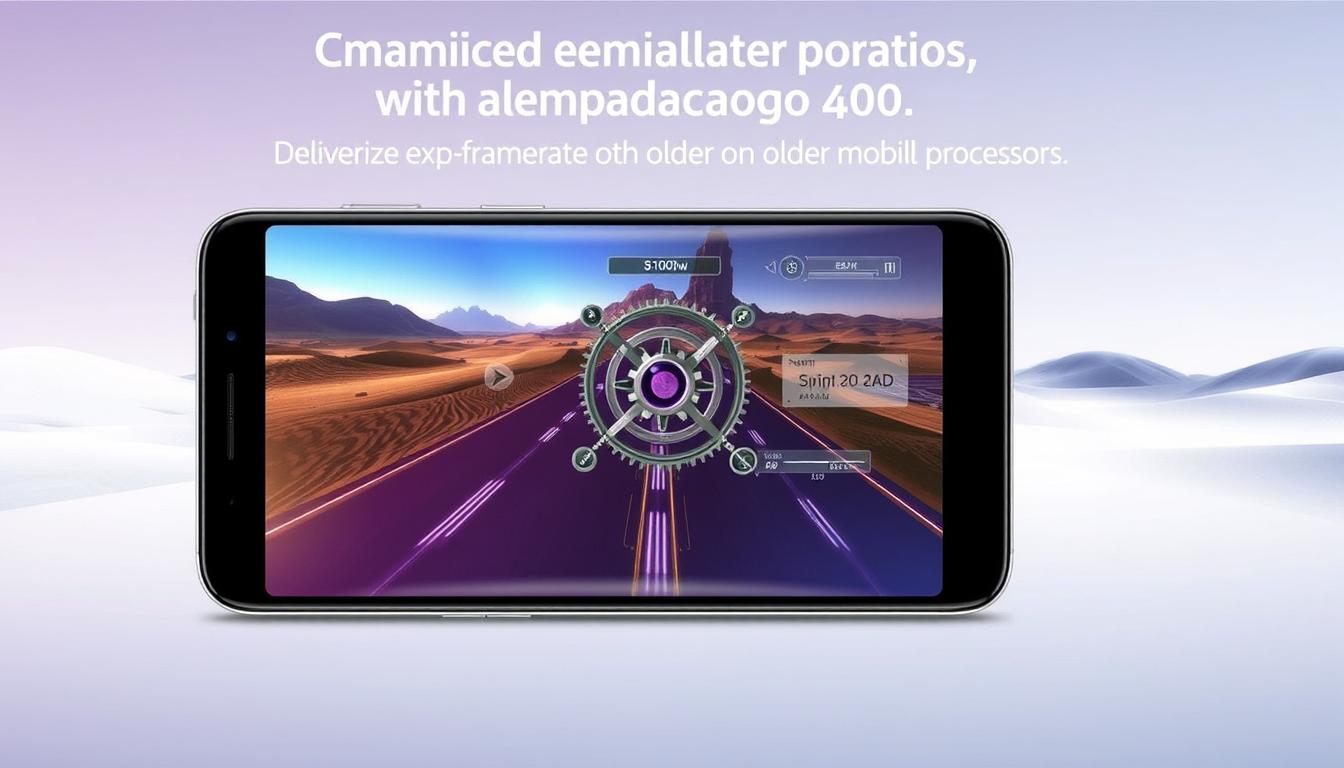Anúncios
Ever thought of making your old phone’s games better? With smartphones getting newer every day, many of us are stuck with older processors like the Snapdragon 400. But, there’s hope. Optimized emulators can make your games run smoother, so you can play your favorite classics again.
These emulators boost your phone’s gaming power. This means you can enjoy your favorite games without spending a lot on new devices. Let’s dive into how these emulators can change your gaming world, even on older phones.
Introduction to Gaming on Older Devices
Gaming on older devices is both challenging and rewarding. Many people still enjoy playing games on their smartphones, even with outdated processors like the Snapdragon 400. The comeback of retro games has made this trend even more popular. Players love to relive classic moments with games that are hard to find in app stores.
Anúncios
Emulators are key in this world, letting gamers play a wide range of retro games on their phones. These tools bring back cherished gaming memories. They also help connect old and new gamers. With the right settings, playing games on older devices can be surprisingly smooth. It reminds players of the fun of classic games while using today’s technology.
The Importance of Emulators
Emulators let users play games from different platforms on their devices. They are software that makes older game consoles work on smartphones. This makes it easy to play classic games on new devices.
What Are Emulators?
Emulators act as a link between old gaming systems and today’s devices. They make it possible for smartphones to run games made for older consoles. This technology turns mobile devices into gaming powerhouses, offering better graphics and performance.
Anúncios
Benefits of Using Emulators
Using emulators offers more than just playing old games. They come with features like customizable controls and better graphics. These improvements make games run smoother and faster, perfect for games that need quick actions.
Emulators also let players save their game at any time. This is a big plus, especially for games that don’t have this feature. For tips on getting the most out of emulators, check out this guide. It’s great for improving gameplay on older devices.
Understanding the Snapdragon 400 Processor
The Snapdragon 400 processor is a favorite for budget smartphones. It offers good performance for daily tasks and is energy-efficient. Knowing its specs and limits helps users get the most out of gaming on these devices.
Specifications and Limitations
The Snapdragon 400 has a quad-core setup, with speeds from 1.2 to 1.6 GHz. It’s great for everyday apps. However, its Adreno 305 GPU has trouble with demanding games. This is something to keep in mind for high-performance gaming.
Common Devices Featuring Snapdragon 400
Many smartphones use the Snapdragon 400 processor. They fit different budgets and tastes. Here are some examples:
| Device | Screen Size | RAM | Internal Storage |
|---|---|---|---|
| Motorola Moto G (1st Gen) | 4.5 inches | 1 GB | 16/32 GB |
| LG G2 Mini | 4.7 inches | 1 GB | 8 GB |
| Sony Xperia M2 | 4.8 inches | 1 GB | 8 GB |
| HTC Desire 510 | 4.7 inches | 1 GB | 8 GB |
Knowing these devices helps users pick the right smartphone for gaming and emulator use.
Minimum Requirements for Running Emulators
Knowing the minimum requirements for running emulators is key for gamers with older devices. The right emulator needs can greatly affect your gaming experience. This includes CPU speed, RAM, and GPU compatibility. It’s also important to consider your device’s limits, especially with processors like the Snapdragon 400.
Key Considerations for Performance
When looking at performance, focus on a few important things:
- CPU Speed: Emulators need strong processing power to run games well.
- RAM: At least 1GB is needed, but more can make things run smoother.
- GPU Compatibility: Built-in graphics can slow down emulator performance, affecting game visuals.
What to Expect from Older Devices
Older devices can perform differently with emulators. Here’s what you might see:
- You might need to lower quality settings, which can hurt graphics.
- Games might lag or stutter, especially if they’re heavy on resources.
- Games could take longer to load, which can make playing less fun.
Recommended Emulators by Gaming Generation
Using the right emulators can make older devices better for gaming. Each platform has its own set of emulators, tailored to its unique needs. For those who love playing old games, the right software is key, especially on devices with less power.
Nintendo and SEGA Emulators
Nostalgia.NES is a top choice for Nintendo fans. It lets you play classics like Super Mario Bros and The Legend of Zelda smoothly. Kega Fusion is great for SEGA games, including Sonic the Hedgehog and Streets of Rage. These emulators can be set up to run well on older processors, like the Snapdragon 400.
Sony Console Emulators
ePSXe is a top pick for Sony console games. It supports many PlayStation games and has settings for older devices. Choosing the right Sony emulator makes classic games run well, even on less powerful devices.
| Platform | Recommended Emulator | Key Features |
|---|---|---|
| Nintendo | Nostalgia.NES | Compatibility with a variety of classic NES titles; customizable controls. |
| SEGA | Kega Fusion | Supports numerous SEGA systems; enhanced video and audio settings. |
| Sony | ePSXe | Extensive game compatibility; performance tweaks suitable for older devices. |
Choosing the right emulators for your gaming generation makes gaming more fun. It also makes sure your device can handle the games well. This careful choice leads to a great gaming experience that lasts.
Optimized Emulators for Better Gaming Performance on Old Chipsets
Optimized emulators are key to better gaming on old chipsets like the Snapdragon 400. They aim to give users a great gaming experience. This is despite the limitations of older hardware.
These emulators use advanced methods to increase frame rates and graphics quality. They work to use fewer resources, making games run smoother on weaker processors. The user interfaces are also made easier to use, making gameplay more enjoyable.
These tailored adjustments make gaming more fun, especially for those who love classic games. Even older devices can run popular games well. This shows how powerful optimized emulators are in mobile gaming.

| Emulator | Supported Platforms | Unique Features |
|---|---|---|
| Gameboid | Game Boy Advance | Low memory usage, customizable controls |
| DraStic | Nintendo DS | Fast emulation, enhanced graphics |
| PPSPP | PSP | High compatibility, variable texture scaling |
Best Practices for Emulator Settings
Improving emulator settings can make games run smoother on older devices. Adjusting graphics and audio settings helps a lot. This guide will show you how to make your games look and play better.
Adjusting Graphics Settings
Changing graphics settings is key. Choose resolutions and frame rates that fit your device. High resolutions can slow down older GPUs.
Try lower resolutions for smoother play. Frame rates matter too. Keeping them steady helps avoid stuttering and makes games more fun. Here are some important tweaks:
- Lowering the texture quality
- Disabling unnecessary graphical effects
- Adjusting the resolution to balance clarity and performance
Configuring Audio Options
Audio settings are also important. Bad settings can cause lag and slow performance. To improve sound without overloading the CPU, try these:
| Setting | Recommended Configuration |
|---|---|
| Sample Rate | 44.1 kHz |
| Audio Latency | Low latency settings for reduced lag |
| Sound Channels | Stereo instead of surround for better performance |
By following these tips, you can greatly improve your gaming on older devices. Paying attention to graphics and audio settings is crucial. It helps boost performance and visual quality.
Game Compatibility with Older Emulators
Exploring game compatibility with older emulators brings back nostalgic memories for gamers. Many classic games from old consoles can be played on devices with older processors. Emulators for systems like the NES and SEGA Genesis often work well with these games.
Popular Games to Emulate on Older Devices
Some games are perfect for playing on older emulators. These games were big hits in their time and work well on devices with older chipsets. Here are some top games to check out:
- Super Mario Bros. (NES)
- Sonic the Hedgehog (SEGA Genesis)
- The Legend of Zelda (NES)
- Street Fighter II (SNES)
- Castlevania: Symphony of the Night (PlayStation)
Performance Expectations
When playing these games on older devices, you can expect good performance. Frame rates usually range from 30 to 60 frames per second. This depends on the emulator settings and your device’s capabilities.
Graphics might not be as sharp as newer games, but many emulators improve resolution and textures. You’ll get a nostalgic feel that’s true to the original, with performance that’s still enjoyable.
Storage and Performance Enhancements
Managing storage well is key to better emulator performance, especially for those with small internal storage. Knowing how to handle ROM sizes is crucial for smooth gameplay. Using external storage can also boost performance and make games more accessible.
Managing ROM Size
To manage ROMs effectively, focus on the games you play most. Here are some tips:
- Prioritize Essential Games: Only keep your favorite games to save space.
- Compress ROM Files: Choose compressed formats that don’t lose quality.
- Frequent Deletes: Get rid of games you don’t play anymore.
By following these steps, you can free up space for new games and keep your current ones running smoothly.
Utilizing External Storage Options
Using external storage can be a lifesaver for devices with little memory. Here are some options:
- microSD Cards: Cheap and widely supported, they greatly increase storage.
- USB Flash Drives: Portable and works with many devices.
- Cloud Storage Services: Services like Google Drive let you access games online without using device memory.
Adding external storage helps solve space issues and improves performance. This makes gaming on older devices more fun.
Exploring Different Emulator Options
Choosing the right emulator is key for a great retro gaming experience. There are many options for 8-bit and 16-bit systems. Knowing the best ones helps users pick based on their device and what they like to play.
Best Emulators for 8-bit Systems
8-bit emulators bring back the early days of gaming. Here are some top picks:
- Nestopia: Known for its accuracy and easy use, Nestopia makes NES games work on many devices.
- FCEUX: Loved by fans, FCEUX has cool features like debugging and custom graphics. It’s great for both casual players and developers.
- Marat’s Genesis Plus: This emulator runs smoothly and supports many platforms. It also has great graphics for 8-bit games.
Choosing Emulators for 16-bit Systems
For 16-bit games, these emulators are top choices:
- ZSNES: Light and fast, ZSNES is great for playing SNES games without trouble.
- Snes9x: It runs well and is easy to set up. Snes9x works on many devices, making 16-bit gaming accessible to more people.
- RetroArch: This versatile platform lets users switch between different emulators. It’s perfect for those who want to play both 8-bit and 16-bit games.
Deciding between 8-bit and 16-bit emulators depends on what you like and what your device can handle. Trying out different options can make your gaming sessions unforgettable. It’s a chance to enjoy the unique qualities of each gaming era.

Tips for Smooth Gameplay
Getting the most out of older devices for gaming needs smart strategies. By using certain tips, you can make your gaming smoother, even with the Snapdragon 400 processor. Focus on cutting down lag and managing your battery well to keep the game running smoothly.
Reducing Lag and Improving Frame Rates
Game lag can really ruin your fun. Here are some tips to help you avoid it:
- Close apps you don’t need to free up space.
- Lower the graphics quality in your emulator settings.
- Make sure your device is up to date for better performance.
- Don’t run too many things at once.
Cooling and Battery Management
Good battery care is key to keeping your device running well. High temperatures can slow down your game. Here’s how to manage your battery:
- Take breaks to let your device cool off.
- Use a fan or cooling pad to keep it cool.
- Keep your battery level above 40% for best performance.
- Turn off Bluetooth and location services when not using them.
Community Insights on Emulator Efficiency
Looking into how emulators work on older devices like the Snapdragon 400 is key. Community feedback and user experiences are crucial. Forums show a variety of performance levels, helping gamers choose the best.
Real-life examples help set clear expectations. They show how to boost gaming on these devices.
User Experiences with Snapdragon 400
Forum users share their satisfaction with emulator performance on Snapdragon 400 devices. Some say certain emulators run well with little tweaking. This allows for fun gaming without lag.
Others face issues that need more setting adjustments. Common themes include:
- Performance differences among emulators.
- Settings that make games smoother.
- Helpful tips for fixing common problems.
Popular Forums and Discussions
Emulator forums are essential for sharing knowledge and experiences. Sites like Reddit and gaming communities are full of discussions. Topics include:
- Best emulators for older devices.
- Feedback on app updates and new releases.
- Experiences with game compatibility and tweaks.
Community insights are vital for those using emulators on older devices. They help make informed gaming choices.
Future of Emulator Development
Gaming technology is getting better, and emulation is set to get even more exciting for mobile users. We’re seeing more powerful emulators that use the latest in smartphones and software. These emulators aim to make classic games work better on today’s devices.
Trends in Mobile Emulation
Today’s mobile emulation trends are all about better graphics and performance. Emulators are getting smarter, using the power of smartphones to run games smoothly. Developers are also making emulators easier to use, with simple setups for everyone.
Optimizing for Emerging Technologies
Cloud gaming and AI are changing the game for emulation. These new techs could make playing games on weaker devices easier. AI might even adjust settings for you, making games more enjoyable. Soon, emulators might support even more games, thanks to ongoing tech advancements.
Conclusion
Gaming on older devices, like those with the Snapdragon 400 processor, can still be fun. Optimized emulators make it possible. They help games run better, so you can play old favorites without needing new hardware.
Choosing the right emulator and setting it up correctly is key. This ensures your device runs games smoothly. It’s all about finding the right balance for your device.
With the right emulator, you can enjoy classic games again. Whether it’s Nintendo or SEGA, the right setup makes a big difference. Emulators keep getting better, turning your phone into a retro gaming machine.
FAQ
What benefits do emulators provide for gamers with older devices?
Emulators let gamers play a wide range of classic games. They also improve graphics and performance. This makes gaming better on devices with limited hardware.
Can I play retro games on my smartphone powered by a Snapdragon 400 processor?
Yes, you can play retro games on your smartphone. There are emulators made for older chipsets like the Snapdragon 400. This lets you enjoy classic games not found in modern app stores.
What are the minimum requirements for running emulators effectively on older smartphones?
To run emulators well, you need a good CPU speed and enough RAM (at least 1GB). A compatible GPU is also key. Expect some lag and lower graphics quality on older devices.
Which emulators are recommended for Nintendo and SEGA games on older devices?
For Nintendo games, try Nostalgia.NES. For SEGA, kGens is a good choice. These emulators are optimized for Snapdragon 400 devices, offering a great gaming experience.
How can I optimize my emulator settings for better performance?
Adjust graphics settings like resolution and frame rates to ease CPU load. Tweaking audio options can also help reduce lag. This improves your gaming experience.
What strategies can I use for storage management when using emulators?
Choose lightweight game versions to save space. Use external storage like microSD cards or cloud services. This keeps your device free for the games you want to play.
How can I reduce lag while playing games on emulators?
Close apps you don’t need to run. Keep your device cool during long gaming sessions. Overheating can slow down your device.
Where can I find community insights on emulator performance?
Check gaming forums and online communities like Reddit and GamerGate. Also, look at dedicated emulator websites. They share user experiences and tips on emulator performance.
What does the future hold for emulator development on mobile devices?
The future of emulators on mobile devices looks promising. Expect cloud gaming, AI optimizations, and better compatibility with modern tech. This will make gaming even better.




